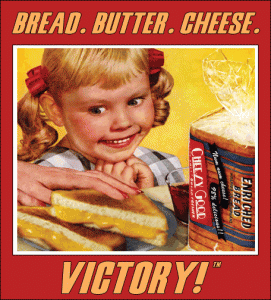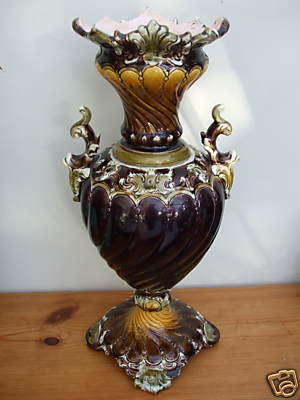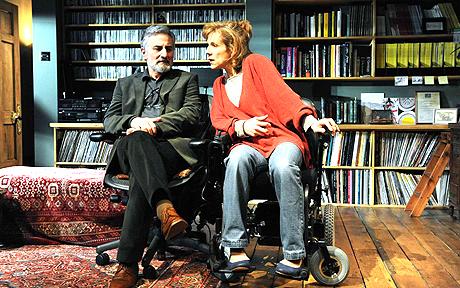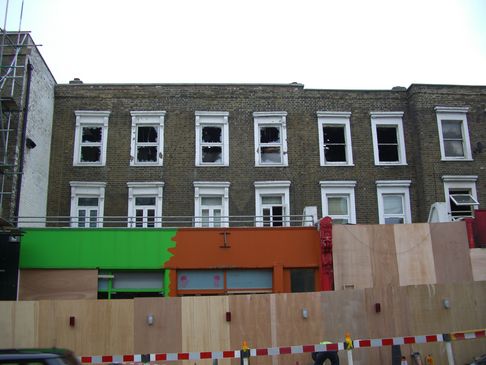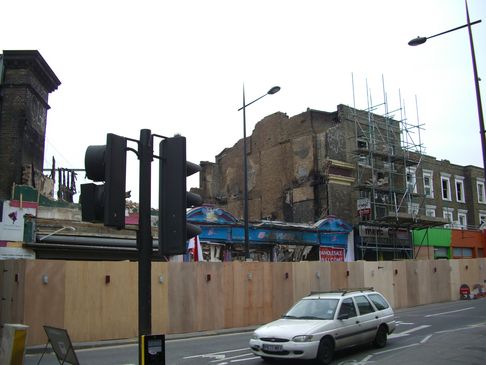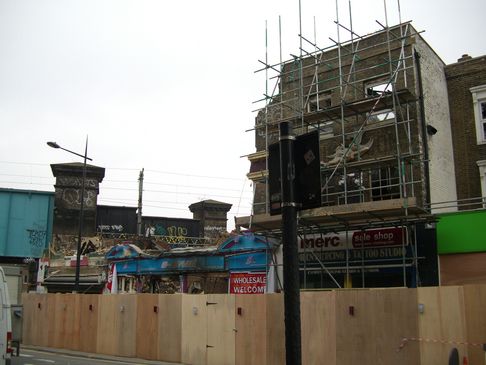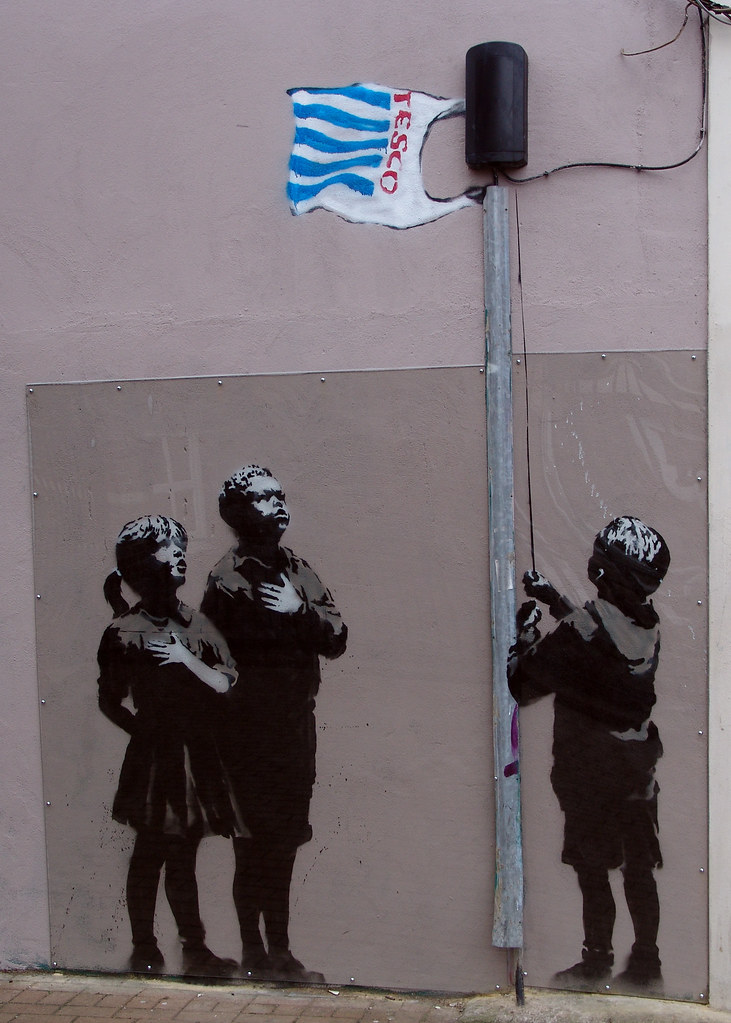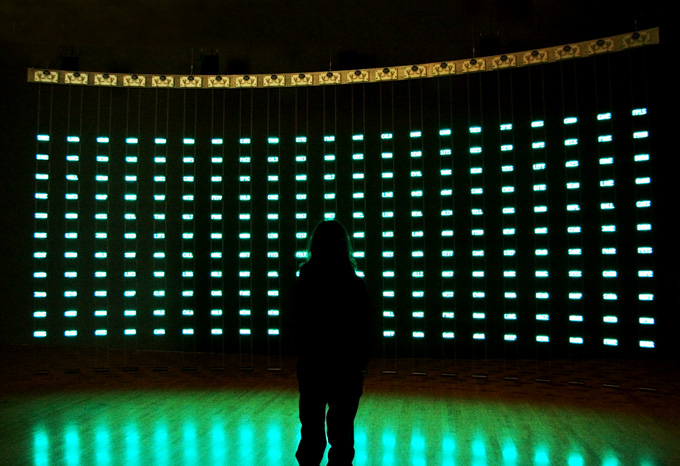[Note: We started this post on 5 May, but have only just now gotten around to completing our review. Please forgive this slide in our duties.]
Last evening we went to see “England People Very Nice.” A controversial new play premièring at the National Theatre. This is a difficult beast, social satire in a full length form, clocking in at 2:50 with interval.
We discussed it a bit last night, during and after, but were too tired to give it proper treatment here. We decided to let it be, sleep on it, and write in the morning. Here we are, so here goes.
England People Very Nice is an ensemble piece with a very large cast. The stage is spare, with a large wall of wooden construction occupying the centre rear of the stage and miscellaneous chairs and such scattered about. Prior to the start of the show a gentleman settles down into a folding chair centre stage with his laptop and his paper whilst the audience mills about and gets settled themselves. Suddenly a voice crackles over the house intercom, “Notes please. All assemble for notes.” And thus begins our play, we are soon to learn that this is a holding prison for inmates, illegal immigrants awaiting news of their status review, and they are putting on a show. Led by a liberal do-gooder, the inmates launch into a final dress rehearsal of their show, and we are along for the ride.
The first act is a telling, in foreshortened form, of the history of England. The arrival of the Romans, the Saxons, the successive waves of immigration from France, Ireland, Denmark and Holland. The humour is very broad, almost like a skit show – and like so many skit shows it suffers at times, when the the comedy fails the show has precious little left to stand on. A theme of repetition quickly develops. There are two characters, in the outer play they are Sanji, an illegal from Pakistan or Bangladesh or somewhere like that (no specifics) and Camille, an illegal from somewhere in the former Soviet block. These two, in each iteration of the waves of immigration, fall in love at first sight (and quickly couple), but are, of course, star crossed. Similarly, there is a bar maid, Ida and her boss, Laurie, who wryly observe the goings on. Ida, with the mouth of a cockney bar maid, begins each scene with a comment of the form, “Fecking Frogs,” where the pejorative term for whatever race is substituted for Frogs. It is this aspect of the show, its bald faced exposure of prejudice and hatred, which garnered it on-stage protests early in its run.
By interval we were up to roughly the turn of the last century, and took a break. I asked X what she thought.
—
Like Nic, I was at this point baffled by the uproar this play caused in sophisticated London (there was a protest early in the run in which attendees stormed the stage, and occupied it until the performance was canceled). What’s the big fuss? Drunken, incestuous micks, perpetually farting and mincing frogs, rapacious or anarchist yids, etc. Maybe if South Park still upsets you, but come on now. One recurring exchange that brought a reliable laugh from the audience was, “This is the closest we will ever get to paradise on earth!” with the disbelieving response, “Bethnal Green?????” What I liked most was the brilliant use of animation on the rough wooden structure behind the actors. As in any farce, there were endless exits and entrances and slamming doors and windows, but with the projections, you saw crowds running down streets, a shop become a church then transformed into a synagogue. Ida’s pub in the corner is a constant, with her marrying a wealthy and well established Jewish man, and her “regular” offering his comments. “Aye, I have them living upstairs from me, the…” [insert current disfavoured ethnic group here] The subversive element is the colorblind casting [or whatever the current term is]. An Indian actor plays a weaver from Norfolk, an Italian priest, a Jewish Russian printer, etc. OK, wine is drunk and the interval* is over.
*Travel tip: order your intermission cocktail before the play starts and it’s right there for you – drink efficiently, I say! xx X
—
Okay, another voice heard from. My take at interval was that this is a show that belonged in the ranks of Off-West-End, perhaps on a smaller stage up in Hackney or somewhere else on the East End or North London. But the National?!? This just reeked of PC over-reach to me. Guilty Liberal self flagellation and the like. But what was it doing here, and what did it really contribute to the national dialogue on immigration, and issue with which the British, like most of Northern Europe, are struggling (as I referenced last year: http://www.fortunespawn.com/2008/02/23/london-journal-day-12-a-close-up-view-from-abroad ).
We finished our wine, and whining, and repaired to the theatre for the second act.
First, however, a personal note. The first act shows the impact of the Jewish immigrant wave brought about by the Tzar’s pogroms near the end of the 1800s. This strikes a chord with me, as this is when my forebears, my great grandparent’s people, fled Ukraine for England’s promise. They settled in the Tower Hamlets district in the East End, and while I know little about that generation, my grandfather was the stereotypical Jewish furrier and tailor, with his workshop and home in Stepney Green until it was bombed in the Battle of Britain. My father, at this point entering medical school, worked as a corps man, collecting the remains of those who perished in the streets during the Blitzkrieg.
Act two begins with the onset of the second world war, and we see the members of the Indian Merchant Marine who worked so hard at the aid of the British to keep supplies moving in treacherous seas. Some are coming ashore on leave but others have swum ashore to strike out for work and a new life. In this half of the show we are brought face to face with the still entrenched class-ism and hostility to immigrants modern Britain is known for. In this half we follow primarily one story, the lives of a Bangladeshi immigrant, Mushi, and Deborah, the daughter of Ida, the bar maid. These two actors, Sacha Dhawan and Michelle Terry, have played the recurring love-at-first-sight characters throughout the show, but now they settle down into the same roles for the rest of the night. There is an odd bit of playing with the time line as the act starts with WWII and ends in a post-9/11 era, but in the character’s lives it is only about 30 years.
We see Mushi go from merchant seaman deserter to assistant to the Attar, to the invention of Chicken Tikka Marsala and, as a wealthy restaurateur, a leader of the Bangladeshi immigrant community in his part of Bethnal Green. Deborah, when we first meet her, is a 14 year old of questionable morals who proudly works in a factory making parts for something war related (she doesn’t know what, as is explained in a lovely ensemble musical number evocative of the burlesque hall style). She falls in love with Mushi, with whom she spends a night in a bunker during an air raid, but is already set to be married to Hugo, a criminal miscreant in her father’s gang. Ida (nee Houlihan), a black Irish lass is married to Harvey Klienman, a Jewish thief.
Mushi is destined, he believes, to sire twins with the daughter of a Christian and a Jew, thus bringing together the three faiths, Christianity, Judaism and Islam. Harvey is not convinced, nor Ida, so Deborah does get married to Hugo and tension develops between the now swelling populations of Indo-Asian immigrants from Pakistan, India, Bangladesh and the Irish, Jews, Jamaican and other cockney residents of the East End Burroughs of Bethnal, Bethnal Green, Spittlefields, Stepney; the “Tower Hamlets” they are called for their proximity to the Tower of London, which marks the eastern edge of the City of London.
The story progresses up to the modern day with the tensions between these groups increasing, the British born offspring of the first generation immigrants bridling under the oppressive hatred of the “natives” and the rise of the National Front (“Britain for the British!”). While the comedy continues, there is a much heavier tone to this act. The tension between the “tribes” in the first act was comical and absurd. Not any more. Now it is violent and vitriolic.
—
We’re writing this several days later, and the impact of the second act, and the play as a whole lingers with me. Now, the animation washes over the wooden structure and the ceiling above. The bombs of the Blitz, the roar of the 9/11 jets, the graffiti covered buildings of Brick Lane, the skinhead scrawls on walls, the church/synagogue now a mosque…the laughable racism of the past now dead serious. The audience quiets, able now to laugh only at “themselves” – the wealthy, white couple who move in with the hope that the area is going to gentrify. The woman carries a Whole Foods grocery bag, and, after the man is mugged and beaten by a gang, believes that as a liberal he can only blame himself. – X

